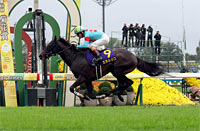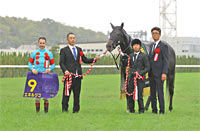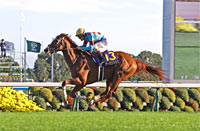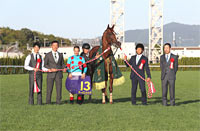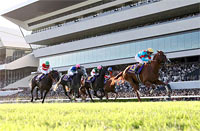Kikuka Sho (Japanese St. Leger) (G1) - Data Analysis
Long-distance race that puts true strenght to the test
The 3,000m distance of the Kikuka Sho (Japanese St. Leger) will be a first experience for all of the runners. The final leg of the classic Triple Crown attracts many contenders each year, and has consistently been contested by a full field of 18 runners since 2006. Among the last five winners, Kitasan Black, Satono Diamond, and Fierement went on to triumph in a mixed-age domestic G1 race, which suggests the Kikuka Sho can also serve as an indicator of future performance. Let’s now confirm some trends in this race based on results over the last 10 years.
Check performance by favoritism
Looking at performances by runners over the last 10 years in terms of favoritism and win odds, we note that race favorites achieved a Win ratio of 50.0% and a Top 3 ratio of 70.0%. The only race favorites beaten to 4th or lower were Reach the Crown (5th in 2009), One and Only (9th in 2014), and Blast Onepiece (4th in 2018). Meanwhile, the three runners with win odds in the 1.0-1.9 range all won the race. Among runners with win odds in the 1.0-2.9 range, only one runner failed to make the Top 2: One and Only (2.4 in 2018). While many runners backed as 6th favorite or lower entered the Top 3, runners backed as 11th favorite or lower struggled. Turning to win odds again, runners with win odds in the 10.0-19.9 and 20.0-29.9 ranges both produced over five Top 3 finishers, but runners with win odds in the 30.0-49.9 range produced zero winners and a total of three runners-up/third-place finishers. Runners with win odds of 50 or above produced zero runners-up and only one third-place finisher. [Table 1] [Table 2]
[Table 1] Performance by favoritism (last 10 years)
| Favoritism |
Performance
[1st-2nd-3rd-4th or lower] |
Win ratio |
Top 2 ratio |
Top 3 ratio |
| 1st favorite |
5-1-1-3 |
50.0% |
60.0% |
70.0% |
| 2nd favorite |
0-3-0-7 |
0% |
30.0% |
30.0% |
| 3rd favorite |
1-0-2-7 |
10.0% |
10.0% |
30.0% |
| 4th favorite |
0-1-0-9 |
0% |
10.0% |
10.0% |
| 5th favorite |
1-2-0-7 |
10.0% |
30.0% |
30.0% |
| 6th, 7th favorite |
2-1-4-13 |
10.0% |
15.0% |
35.0% |
| 8th-10th favorite |
1-2-1-26 |
3.3% |
10.0% |
13.3% |
| 11th-13th favorite |
0-0-2-28 |
0% |
0% |
6.7% |
| 14th favorite or lower |
0-0-0-50 |
0% |
0% |
0% |
[Table 2] Performance by win odds (last 10 years)
| Win odds |
Performance
[1st-2nd-3rd-4th or lower] |
Win ratio |
Top 2 ratio |
Top 3 ratio |
| 1.9 or lower |
3-0-0-0 |
100% |
100% |
100% |
| 2.0-2.9 |
1-1-0-1 |
33.3% |
66.7% |
66.7% |
| 3.0-4.9 |
1-2-1-5 |
11.1% |
33.3% |
44.4% |
| 5.0-6.9 |
1-0-0-7 |
12.5% |
12.5% |
12.5% |
| 7.0-9.9 |
0-2-0-3 |
0% |
40.0% |
40.0% |
| 10.0-19.9 |
3-2-4-26 |
8.6% |
14.3% |
25.7% |
| 20.0-29.9 |
1-2-2-21 |
3.8% |
11.5% |
19.2% |
| 30.0-49.9 |
0-1-2-23 |
0% |
3.8% |
11.5% |
| 50 or higher |
0-0-1-64 |
0% |
0% |
1.5% |
Focus on inner brackets
Looking at performances by runners over the last 10 years in terms of bracket number, we find that runners starting in Bracket 1 and Bracket 2 notably produced three winners each. In addition, runners starting in Bracket 6 and Bracket 7 also delivered strong performance. These are trends we should also keep in mind [Table 3]
[Table 3] Performance by bracket number (last 10 years)
| Bracket number |
Performance
[1st-2nd-3rd-4th or lower] |
Win ratio |
Top 2 ratio |
Top 3 ratio |
| 1 |
3-0-1-16 |
15.0% |
15.0% |
20.0% |
| 2 |
3-3-0-14 |
15.0% |
30.0% |
30.0% |
| 3 |
1-0-0-19 |
5.0% |
5.0% |
5.0% |
| 4 |
0-0-1-19 |
0% |
0% |
5.0% |
| 5 |
0-2-2-16 |
0% |
10.0% |
20.0% |
| 6 |
1-2-2-15 |
5.0% |
15.0% |
25.0% |
| 7 |
2-2-3-23 |
6.7% |
13.3% |
23.3% |
| 8 |
0-1-1-28 |
0% |
3.3% |
6.7% |
Also check performances by body weight
In athletics, short-distance runners are typically expected to have a muscular build while marathon runners are assumed to have a leaner frame. However, looking at performances by runners in the Kikuka Sho—which is contested over a long distance—over the last 10 years in terms of body weight, we observe that runners weighing in at 480-498kg have been strong performers. Incidentally, runners weighing in at less than 460kg have only produced one winner: Big Week in 2010 (450kg). Meanwhile, runners weighing in at 500kg or more delivered two winners: Gold Ship in 2012 (500kg) and Kitasan Black in 2015 (530kg). [Table 4]
[Table 4] Performance by body weight (last 10 years)
| Body weight |
Performance
[1st-2nd-3rd-4th or lower] |
Win ratio |
Top 2 ratio |
Top 3 ratio |
| 438kg or less |
0-0-2-5 |
0% |
0% |
28.6% |
| 440-458kg |
1-1-0-19 |
4.8% |
9.5% |
9.5% |
| 460-478kg |
1-2-3-42 |
2.1% |
6.3% |
12.5% |
| 480-498kg |
6-5-2-55 |
8.8% |
16.2% |
19.1% |
| 500-518kg |
1-2-3-19 |
4.0% |
12.0% |
24.0% |
| 520kg or more |
1-0-0-10 |
9.1% |
9.1% |
9.1% |
Runners coming straight from the Kobe Shimbun Hai perform well
In 2018, Fierement won the Kikuka Sho after last contesting the Radio Nikkei Sho in July, but this was atypical.
The bulk of the Top 2 finishers in the Kikuka Sho have come straight from trial races such as the Kobe Shimbun Hai and St. Lite Kinen. In addition, 19 of the 20 Top 2 finishers over the last 10 years had contested a graded race last time out. Looking at performances in terms of finish last time out, 19 of the 20 Top 2 finishers had entered the Top 3 in their previous race, with 2017 runner-up Clincher being the exception (9th in previous outing in St. Lite Kinen). [Table 5] [Table 6]
[Table 5] Performance by previous race (last 10 years)
| Previous race |
Performance
[1st-2nd-3rd-4th or lower] |
Win ratio |
Top 2 ratio |
Top 3 ratio |
| Kobe Shimbun Hai |
7-6-4-49 |
10.6% |
19.7% |
25.8% |
| St. Lite Kinen |
1-3-1-46 |
2.0% |
7.8% |
9.8% |
| Other graded race |
1-1-0-8 |
10.0% |
20.0% |
20.0% |
| Open-class race |
0-0-0-2 |
0% |
0% |
0% |
16 million yen-or-less class
(now 3-win class) |
0-0-0-8 |
0% |
0% |
0% |
10 million yen-or-less class
(now 2-win class) at Hanshin Racecourse |
1-0-2-13 |
6.3% |
6.3% |
18.8% |
10 million yen-or-less class
(now 2-win class) at Niigata Racecourse |
0-0-2-1 |
0% |
0% |
66.7% |
| 10 million yen-or-less class (now 2-win class) |
0-0-1-21 |
0% |
0% |
4.5% |
| 1-win class |
0-0-0-2 |
0% |
0% |
0% |
[Table 6] Performance by finish last time out (last 10 years)
| Finish last time out |
Performance
[1st-2nd-3rd-4th or lower] |
Win ratio |
Top 2 ratio |
Top 3 ratio |
| 1st |
6-1-6-43 |
10.7% |
12.5% |
23.2% |
| 2nd |
2-5-1-17 |
8.0% |
28.0% |
32.0% |
| 3rd |
2-3-1-14 |
10.0% |
25.0% |
30.0% |
| 4th, 5th |
0-0-2-25 |
0% |
0% |
7.4% |
| 6th or lower |
0-1-0-51 |
0% |
1.9% |
1.9% |
Watch performance in graded spring races
In the last 10 Kikuka Sho races, runners that “had finished 4th or 5th in a graded spring race within their last five races” entered the Top 2 every year except 2009 and 2014. We should check whether any of this year’s runners come with this type of record. [Table 7]
[Table 7] Kikuka Sho Top 2 finishers that had finished 4th or 5th in a graded spring race (last 10 years)
| Year |
Finish |
Horse |
Race in question |
| 2010 |
2nd |
Rose Kingdom |
3 races back |
Satsuki Sho (Japanese 2000 Guineas) |
4th |
| 2011 |
2nd |
Win Variation |
5 races back |
Kisaragi Sho |
4th |
| 2012 |
1st |
Gold Ship |
2 races back |
Tokyo Yushun (Japanese Derby) |
5th |
| 2013 |
1st |
Epiphaneia |
4 races back |
Yayoi Sho |
4th |
| 2nd |
Satono Noblesse |
3 races back |
Aoba Sho |
4th |
| 2015 |
2nd |
Real Steel |
2 races back |
Tokyo Yushun (Japanese Derby) |
4th |
| 2016 |
2nd |
Rainbow Line |
4 races back |
New Zealand Trophy |
5th |
| 2017 |
2nd |
Clincher |
3 races back |
Satsuki Sho (Japanese 2000 Guineas) |
4th |
| 2018 |
2nd |
Etario |
2 races back |
Tokyo Yushun (Japanese Derby) |
4th |
Seek out the winner!
Last three winners had won a 1-win class race as the race favorite
The last three winners of the Kikuka Sho “had won a 1-win class race as the race favorite within their last five races.” This year, we should again keep an eye on runners with this type of record. [Table 8]
[Table 8] 1-win class races won by last three Kikuka Sho winners as race favorites within last five races
| Year |
Winner |
Race in question |
| 2016 |
Satono Diamond |
5 races back |
2yo 1-win class |
1st favorite |
1st |
| 2017 |
Kiseki |
3 races back |
3yo+ 1-win class |
1st favorite |
1st |
| 2018 |
Fierement |
2 races back |
Yamafuji Sho |
1st favorite |
1st |
(Yasunori Asano)
|
















